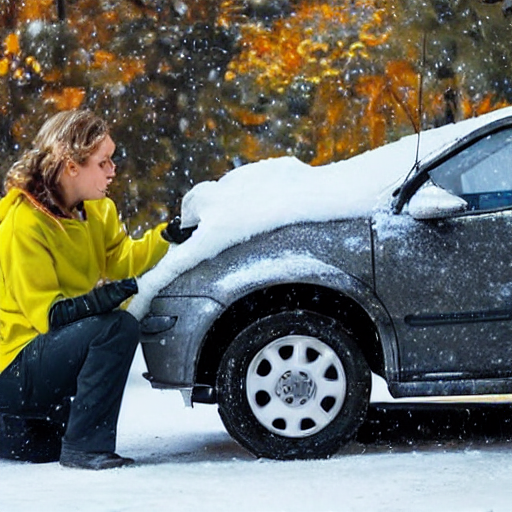
Winter Vehicle Preparation: Get Ready for Seasonal Challenges
Master Winter Driving: Essential Preparations for a Safe Journey
The arrival of winter transforms our environment into stunning, snow-covered vistas that offer a picturesque backdrop for warm fireside evenings. However, beneath this beauty lies a host of challenges, particularly when it comes to navigating icy roads and facing unforeseen emergencies. As conscientious motorists, it is imperative to be thoroughly equipped for any scenario that may unfold during these colder months. Imagine being stranded on a deserted road amidst a winter storm, with no assistance in sight—this daunting thought underscores the importance of preparation. This in-depth guide will detail the crucial steps you must undertake to ensure your vehicle is primed for any winter crisis, granting you peace of mind for safe travels all season long.

Prioritize Your Safety: Thoroughly Remove Snow and Ice from Your Vehicle
Before you set out on your winter journey, it is crucial to ensure that your vehicle is entirely free of snow and ice. Although this task may appear simple, many drivers neglect this vital step, resulting in dangerous driving conditions. Accumulated snow on the roof, hood, or windows can drastically reduce visibility, leading to hazardous situations on the road. In certain instances, snow can slide down onto your windshield while driving, causing a sudden and alarming obstruction of your view. Furthermore, large chunks of snow or ice can become dangerous projectiles, posing risks to other road users. Equip yourself with a sturdy scraper and brush, and diligently remove all snow and ice from your vehicle’s exterior. This proactive measure significantly enhances your safety and that of others while navigating winter roads.
Boost Traction and Vehicle Safety: Conduct a Comprehensive Tire Inspection
Your tires serve as the sole connection between your vehicle and the road, making their condition crucial for adequate grip and safety during winter driving. As the cold weather approaches, it’s essential to evaluate their state, ensuring proper inflation and overall quality. Cold temperatures can lead to decreased tire pressure, which greatly compromises traction on icy or snowy surfaces. Always refer to your vehicle manufacturer’s recommended tire pressure levels, typically found in your vehicle’s manual or on a sticker located on the driver’s side door jamb.
Moreover, the tread depth of your tires plays a pivotal role in your vehicle’s performance on snow and ice. While the legal minimum tread depth may be 2/32 inches, choosing tires with deeper tread will greatly improve grip and handling capabilities. Consider investing in winter or snow tires specifically designed for frigid conditions to ensure superior traction and maneuverability. Remember, maintaining your tires in excellent condition can be the deciding factor that keeps you safely on the road, preventing potentially hazardous situations during winter travel.
Ensure Battery Reliability: Prepare for Cold Weather Starts
Picture being fully geared up for your winter adventure, only to find that your vehicle refuses to start due to a failing battery. Prevent this frustrating scenario by proactively assessing your battery’s health before the temperatures drop. Many auto parts retailers offer complimentary battery inspections, and taking advantage of this service can help confirm that your battery is functioning optimally.
Cold weather places additional strain on your battery, making it essential to keep the terminals clean and free from corrosion. Look for any signs of wear or aging, ensuring all connections are secure. If your battery displays symptoms of nearing the end of its lifespan, it is prudent to replace it proactively, preventing the risk of being stranded in the cold due to a dead battery. Keeping your battery in peak condition is vital for ensuring dependable travel during the winter months.
Maintain Optimal Performance: Check Essential Fluids in Your Vehicle
Maintaining the proper levels of essential fluids in your vehicle is critical for optimal performance during winter driving. Start by checking your engine coolant, commonly referred to as antifreeze, which is designed to prevent your engine from freezing. It is imperative to ensure this fluid is at the recommended levels for efficient operation. If you are unsure about the correct levels, consult your vehicle manual or seek assistance from a qualified mechanic.
Additionally, inspect your windscreen washer fluid. Winter roads can quickly become slushy and dirty, obscuring your visibility. Refill your washer fluid with a winter blend that remains effective even in freezing temperatures. Don’t overlook your brake fluid and engine oil; ensuring these fluids are at appropriate levels is essential as cold temperatures can negatively impact their performance. Properly maintained fluids are crucial for your vehicle’s smooth operation and overall safety, particularly during the winter months.
Be Prepared for the Unexpected: Assemble a Comprehensive Winter Emergency Kit
In the event of a winter emergency, having a well-stocked emergency kit in your vehicle can serve as a crucial safety net. Ensure that your kit contains essential items such as a reliable flashlight, extra batteries, jumper cables, a reflective vest, a warm blanket, gloves, and a hat. Additionally, include a first aid kit, non-perishable snacks, and bottled water as essential supplies to have on hand. You might also consider adding a portable phone charger, a compact shovel, and materials like sand or kitty litter to enhance traction if you find yourself stuck.
Always remember, being prepared for the unexpected is key to safely navigating winter conditions. Regularly check and refresh your emergency kit to ensure you are equipped to handle any situation that may arise. Being proactive can significantly bolster your safety during winter travel, allowing you to appreciate the beauty of the season without undue concern.
Enhance Your Safety: Verify the Functionality of Your Vehicle Lights
With shorter days and longer nights during winter, ensuring that all your vehicle’s lights are functioning correctly is essential for your safety. Take the time to inspect all external lights, including turn signals, brake lights, headlights, and taillights. Replace any burnt-out or dim bulbs to maintain optimal visibility for both yourself and fellow drivers. Proper lighting not only optimizes your visibility while driving but also ensures that you are easily seen by other drivers, thus reducing the risk of accidents during critical moments.
Ensure Clear Visibility: Maintain Your Wiper Blades for Winter Weather
Winter weather often brings a mix of snow, freezing rain, and slushy road conditions that can severely impair visibility. To combat these challenges, it is vital to ensure your wiper blades are in excellent working order. If your current wipers are leaving streaks or failing to effectively clear moisture, it’s time for a replacement. Consider investing in winter-specific wiper blades designed to handle severe weather, as they can significantly enhance your visibility during snowstorms and freezing rain, allowing for safer navigation.
Stay Updated: Regularly Monitor Weather and Road Conditions for Safe Travel
To effectively tackle the challenges of winter driving, staying informed about weather conditions and potential road closures is essential. Before embarking on any journey, check the weather forecast and remain vigilant for possible hazards along your route. Utilizing weather apps, tuning into local news stations, or listening to radio updates can provide you with real-time information on changing conditions.
Furthermore, it’s wise to inform someone of your travel plans, including your intended route and estimated arrival time. This way, should any emergencies occur, someone will know where to look for you. By adhering to these straightforward yet effective strategies, you can be well-prepared for any winter emergency, ensuring a safe journey. Always remember, it’s better to be over-prepared than caught unawares. Embrace the beauty of winter while ensuring your vehicle is equipped to handle whatever challenges lie ahead. Safe travels!
The post Preparing Your Vehicle: Stay Ahead of Winter Challenges appeared first on Survival Bite.
The Article Preparing Your Vehicle for Winter Challenges Ahead Was Found On https://limitsofstrategy.com
The Article Winter Vehicle Preparation for Upcoming Challenges First Appeared ON
: https://ad4sc.com












This post resonates deeply with me, especially as someone who has faced my share of winter driving challenges. The imagery of picturesque winter landscapes is indeed enchanting, but I couldn’t agree more about the underlying risks that come with navigating those icy roads. Preparing for winter driving is not just about the vehicle itself; it’s also a mindset that prioritizes safety and awareness.
I completely get where you’re coming from. Winter driving can really test our skills and our nerves. I remember one particularly snowy night when I underestimated how slick the roads could be, even in an all-wheel-drive vehicle. The scenery outside was so serene, but inside, I was hyper-aware of every turn and brake. It’s funny how those beautiful winter landscapes can be so deceptive; they create a sense of calm while hiding the real dangers.
You make a great point about the hidden dangers beneath that beautiful winter cloak! I remember one year, I was in a hurry and skipped the snow-removal ritual. Not only did I nearly take out a mailbox with a mini avalanche of snow sliding off my roof, but I also turned heads at the traffic light for looking like a mobile snow globe!